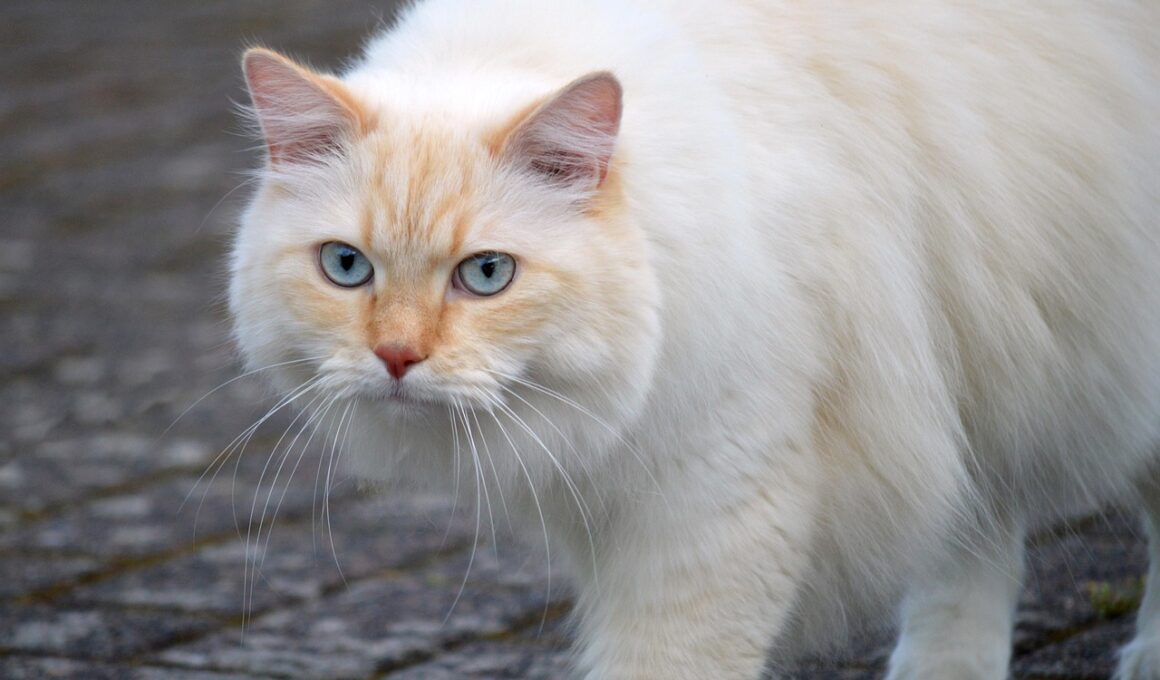Understanding Your Cat’s Body Language When They’re Happy
Recognizing a happy cat involves understanding their body language. A cat expressing happiness often exhibits certain physical behaviors that communicate their emotional state. One of the most telling signs is purring, which typically indicates contentment. When a cat approaches you while purring, it’s expressing affection and happiness. Another sign is kneading, where cats push their paws against soft surfaces, often replicating the comforting motions of kittenhood. This behavior shows they feel secure and happy in their environment. Additionally, watch for tail movements; a straight-up tail often indicates a confident and happy cat. Cats may also exhibit playful behavior, such as chasing toys or engaging in sudden bursts of energy called “zoomies.” This playful nature reflects a joyful state of mind. Scent marking can also be a sign of happiness, as cats rub their scent glands against you, indicating that they consider you part of their territory. Additionally, observe their eyes, as narrowed or half-closed eyelids signal relaxation and comfort. Small meows or chirps can also express happiness, demonstrating that your cat is enjoying your company. Understanding these signs enhances your bond with your feline friend.
Responding effectively to your cat’s happy signals is essential for nurturing their well-being. When your cat approaches you with a raised tail and purring, it’s a clear invitation for interaction. Respond to this by offering gentle strokes and soft words, reinforcing their happiness. Engaging in play when your cat shows excitement can help reinforce positive emotions. Interactive toys, such as feather wands or laser pointers, can stimulate your cat’s senses and contribute to their joy. Equally important is providing a safe environment where your cat feels secure. Create cozy spaces with soft beds or blankets where they can relax and feel protected. Consistent routines also play a vital role in keeping a cat content. Feeding schedules and playtimes should be predictable to foster a sense of stability. Similarly, providing vertical spaces, such as cat trees or shelves, can make your cat feel empowered and happy. When a cat has places to explore and observe, it enhances their overall happiness. Always pay attention to their reactions during playtime and interactions to ensure they are enjoying themselves and not feeling overwhelmed. This attention to detail will help you build a strong relationship with your furry companion.
Environmental Factors That Influence Happiness
Creating a stimulating environment is crucial for enhancing your cat’s happiness. Cats are naturally curious creatures that require mental and physical engagement. Periodically vary their toys to keep their interest alive; consider incorporating puzzle feeders that challenge their problem-solving skills. This can prevent boredom and stimulate their mind, ultimately contributing to their happiness. Providing various scratching posts is also important as this behavior satisfies their need to scratch and helps reduce stress. Besides, it keeps their claws healthy and minimizes destructive tendencies. Additionally, consider adding vertical spaces such as shelving or cat trees to enrich their environment. Cats love to perch high and observe their surroundings, contributing to their sense of safety and happiness. Regularly changing the layout of their spaces can create new experiences and enhance their curiosity. Ensure they have access to natural light, as bright environments with sunlight can uplift their spirits. Plants can also provide mental stimulation; however, ensure they are non-toxic. The presence of other animals can impact happiness as well—if well-matched, a companion can provide socialization and joyous interactions. Being mindful of these environmental factors can significantly improve your cat’s emotional health.
Understanding the nuances of your cat’s body language and habits allows you to respond appropriately to their emotional state. For instance, a cat that exhibits grooming behaviors may be showing contentment or seeking peace. You’ll notice them licking their paws or body systematically, which can also serve as a calming mechanism. Additionally, when your cat rolls over and exposes their belly, it is a vulnerable position that signifies trust and happiness. However, approach with caution, as some cats may not appreciate a belly rub and may react defensively. Furthermore, a cat that blinks slowly at you is showing affection; returning the slow blink can strengthen your bond. The uniqueness of each cat’s personality plays an essential role in understanding their signals. Some cats may greet you with excited chirps or trills, expressing their joy upon your return home. Encouraging these interactions with positive reinforcement will cultivate a deeper emotional connection. Ultimately, by observing the subtle signs of happiness, you not only enhance their joy but also create a fulfilling companionship that benefits both you and your feline friend. Building this connection is essential and can improve both your lives.
Bonding through Playtime
Playtime is crucial for fostering happiness in your cat as it serves multiple purposes. Engaging your cat in play helps them expend energy while satisfying their hunting instincts. Choose toys that mimic the movements of prey, such as feathered toys or small balls, allowing your cat to exhibit natural hunting behaviors. Regular play sessions can significantly uplift a cat’s mood and promote a healthy lifestyle. It’s important to keep interactions varied and engaging, as routine can lead to boredom. Utilize different types of toys and play styles to maintain your cat’s interest. Allow them to dictate the pace by alternating between active play and calmer interactions; this respects their energy levels while fostering a deeper bond. Observing their preferences during playtime can guide you towards activities they enjoy most. Consider providing toys that allow independent play, like puzzle toys where they can earn treats, which also stimulates their mental faculties. Bonding through play creates joyful experiences that contribute to their emotional well-being. Make sure to conclude each session positively, providing praise and treats. This helps your cat associate play with happiness and affection and strengthens your relationship.
Paying attention to your cat’s vocalizations can further enhance your understanding of their happiness. Cats communicate through a range of sounds, from soft purrs to louder meows and chirps. A soft, gentle purr while resting next to you typically signifies contentment and happiness. Conversely, a loud and demanding meow could be a request for attention or food. Understanding the context behind these vocalizations is crucial for responding appropriately to their needs and emotions. Additionally, learn to distinguish between playful chirps and frustrated meows, as this can help you identify their mood more accurately. Some cats even develop distinctive sounds for specific scenarios, making it easier for you to gauge their feelings. Pay attention to changes in vocalization patterns, as they may indicate stress or discomfort instead of happiness. Regular engagement helps your cat feel more secure, leading to more joyful expressions over time. Observe how they react to your presence and the different sounds they make when interacting. Listening to your cat’s unique sounds can help you gauge their mood and allows for specific interactions that strengthen your bond.
Conclusion: The Path to a Happy Cat
Understanding and responding to your cat’s expressions of happiness is fundamental to their well-being. By recognizing the signs of happiness, you can foster a nurturing environment that caters to their emotional needs. This involves observing their body language as well as vocalizations to gauge their feelings accurately. Remember that every cat is unique, and what makes one happy may not apply to another. Therefore, take time to learn your feline’s individual quirks and preferences. Engaging them in play, providing mental and physical stimulation, and creating a safe space are all key factors in enhancing their happiness. Do not forget the importance of your presence; interacting with your cat regularly lets them know they are valued, which boosts their well-being. Positive reinforcement and understanding non-verbal cues are vital for establishing a sound relationship. Ultimately, the bond shared with your cat can flourish as you learn to interpret their signals. Investing time in understanding these aspects leads to a happier, healthier, and more fulfilling relationship with your furry companion. Your cat thrives when their happiness is prioritized, creating a beautiful and loving partnership for years to come.
The signs of cat happiness can go unnoticed without careful observation. The impact of positive emotions on cats should not be underestimated. Several studies indicate that happy cats display healthier behaviors, which includes regular grooming and playfulness. Increased affection levels may lead to enhanced creativity and curiosity in their environment. Providing opportunities for enrichment can boost your cat’s happiness and ultimately improve their life quality. Monitor your feline friend’s behavior closely while acknowledging their happy signs. Response and interaction can encourage this happiness further. Cats that feel nurtured often exhibit joyful behaviors more frequently. Implementing changes in their environment, like introducing new toys or play areas, can spark sudden joy. However, stress management is equally significant; ensuring your cat feels secure will combat any anxiety. Create consistency in routines to maintain their comfort during stress factors, promoting a healthier emotional state. The importance of understanding and nurturing this happiness cannot be overstated. Investing in your cat’s emotional welfare can elevate their life quality and yours as well. A happy cat leads to a harmonious home where joy reigns.


